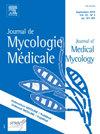一名患有伯基特淋巴瘤的儿童患者被帽状木兰霉菌感染:病例报告和文献综述
IF 1.8
4区 医学
Q3 MYCOLOGY
引用次数: 0
摘要
侵袭性真菌感染是免疫抑制患者的一个严重问题,特别是那些血液或肿瘤疾病患者。最近,更多的新出现的病原体,如Magnusiomyces capitatus,已被报道。临床病例:4岁男性,诊断为IV期蝶骨伯基特淋巴瘤,接受免疫抑制治疗,伴有严重中性粒细胞减少症,并发腹部脓毒症,需要入住重症监护室。他接受经验性抗生素和抗真菌治疗,并在血液培养和腹膜液中分离出头状分枝杆菌。尽管调整了抗真菌治疗,但由于侵袭性真菌感染的进展,患者在15天后死亡。头部感染在免疫功能低下的患者中更为常见。对文献中发表的儿科病例进行回顾,共发现16例(8男8女,中位年龄6岁)。大多数病例有潜在的血液肿瘤疾病,并处于免疫抑制状态。与成人观察到的情况相反,只有3例(18.8%)接受了抗真菌预防治疗。M. capitatus是一种二态酵母,对棘白菌素具有内在抗性,在研究系列和我们的系列中都具有显著的死亡率(50%)。结论快速准确的诊断是控制侵袭性真菌感染的关键,可提高患者的生存率。本文章由计算机程序翻译,如有差异,请以英文原文为准。
Invasive fungal infection caused by Magnusiomyces capitatus in a pediatric patient with Burkitt lymphoma: Case report and review of literature
Introduction
invasive fungal infection is a serious problem in immunosuppressed patients, particularly those with hematological or oncological diseases. Recently, more cases of emerging pathogens, such as Magnusiomyces capitatus, have been reported.
Clinical case
a 4-year-old male diagnosed with stage IV sphenoidal Burkitt lymphoma, undergoing immunosuppressive treatment and with severe neutropenia, developed sepsis of abdominal origin, requiring admission to the Intensive Care Unit. He received empirical antibiotic and antifungal therapy, with isolation of M. capitatus in blood cultures and peritoneal fluid. Despite adjusting antifungal therapy, the patient died 15 days after due to the progression of the invasive fungal infection.
Discussion
M. capitatus infections are reported more frequently in immunocompromised patients. A review of pediatric cases published in the literature identified a total of 16 cases (8 males and 8 females, median age 6 years). Most cases had an underlying hemato-oncological disease and were in an immunosuppressed state. In contradistinction to what is observed in adults, only three cases (18.8 %) had received antifungal prophylaxis. M. capitatus is a dimorphic yeast that is intrinsically resistant to echinocandins and has a significant mortality rate, both in studied series and in ours (50 %).
Conclusions
a rapid and accurate diagnosis of M. capitatus infection is essential to control invasive fungal infection, which could improve patient survival.
求助全文
通过发布文献求助,成功后即可免费获取论文全文。
去求助
来源期刊
CiteScore
5.10
自引率
2.80%
发文量
68
审稿时长
6-12 weeks
期刊介绍:
The Journal de Mycologie Medicale / Journal of Medical Mycology (JMM) publishes in English works dealing with human and animal mycology. The subjects treated are focused in particular on clinical, diagnostic, epidemiological, immunological, medical, pathological, preventive or therapeutic aspects of mycoses. Also covered are basic aspects linked primarily with morphology (electronic and photonic microscopy), physiology, biochemistry, cellular and molecular biology, immunochemistry, genetics, taxonomy or phylogeny of pathogenic or opportunistic fungi and actinomycetes in humans or animals. Studies of natural products showing inhibitory activity against pathogenic fungi cannot be considered without chemical characterization and identification of the compounds responsible for the inhibitory activity.
JMM publishes (guest) editorials, original articles, reviews (and minireviews), case reports, technical notes, letters to the editor and information. Only clinical cases with real originality (new species, new clinical present action, new geographical localization, etc.), and fully documented (identification methods, results, etc.), will be considered.
Under no circumstances does the journal guarantee publication before the editorial board makes its final decision.
The journal is indexed in the main international databases and is accessible worldwide through the ScienceDirect and ClinicalKey platforms.

 求助内容:
求助内容: 应助结果提醒方式:
应助结果提醒方式:


